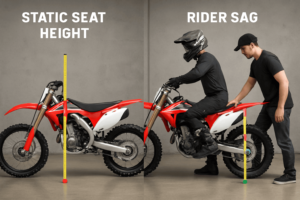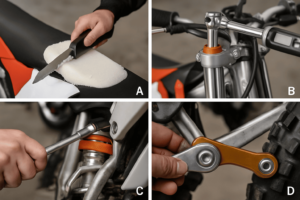Lowering a dirt bike is a useful hack for riders who find the stock seat height to be too high. It allows them to ride their bikes with better balance and control, especially at low speeds or technical riding. It enhances their ability to handle their bikes, giving them better balance and control, particularly at slow speeds or as they navigate challenging tracks. This modification should be performed with great care to avoid any effect on performance or compromise the integrity of the suspension system. If you are still struggling with the question “how to lower a bike,” then this guide is for you.
Table of Contents
ToggleWhy Lowering a DirtBike Is Important
A lower dirt bike is comfortable for short riders. It allows easier mounting, dismounting, and standing. Short riders experience psychological comfort in being able to stand flat on the ground. This choice eliminates nervousness and gives them more confidence while operating stop-and-go. Younger drivers and riders who desire an easier ride opt for a lower bike. It is less intimidating and enables longer travel to be easier.
How Lowering Impacts Ride & Safety
Reducing the ride height of a dirt bike alters its centre of gravity. This influences its handling, particularly when cornering. The front end is more sensitive. Excessive front or rear lowering impacts braking dynamics. Asymmetrical lowering can influence suspension travel, increasing the risk of bottoming out or instability on uneven ground.
How to Measure and Calculate the Correct Saddle Height
First, measure the seat height. Measure from the floor to the top of the saddle when loaded and upright. That will be your zero point for all future measurements. Next, measure the “rider sag.” Have the rider clothed and seated on the bike? Push down on the seat with someone else to get the seat height. Both of these are used to calculate the effective seat height in the ride position.

Getting the Proper Saddle Height for You
Rider preference varies between a full flat-footed stance and partial toe contact, whether it’s a 2-stroke dirt bike built for quick bursts or a trail dirt bike designed for long, rugged rides. Flat-footing may offer security in technical sections but often comes at the cost of lost suspension capability. A general guideline is to match saddle height to rider inseam, allowing for the balls of the feet to make consistent ground contact. Consider terrain, skill level, and intended use when deciding on an optimal stance.
Setting a Reasonable Reduction Target
The majority of riders prefer to drop 25 to 50 millimeters and consider this to maintain suspension performance safely. Dropping a dirt bike below this compromises ground clearance and shock damping.
How To Lower Seat Height On Dirt Bike

There are various methods used to lower the dirt bike seat. Here are a few of them:
Seat Foam Shaving
One of the most common approaches is seat foam shaving. First, take off the cover. Second, re-form or replace the foam in it. Lastly, install a new stock or aftermarket cover. It can create as much as an inch of drop. Low-profile after-market seats are similar in benefit and are typically made for increased thigh clearance.
Advantages: cheap, easy to remove, and reversible.
Disadvantages: less cushioning.
Lowering the Front Fork
The front suspension can be adjusted by raising the fork tubes in the triple clamps. It drops the front of the bike, but do it with caution. It alters the rake and trail, and then the steering becomes unstable. Fork tuning always has to be followed by the same adjustments to the rear. It keeps things even in the chassis.
Dirt Bike Rear Shock Adjustment
There are a variety of rear-lowering possibilities. Preload adjustment to reach rider sag is a temporary measure. It also alters rebound behavior. Reduction links change the rear shock leverage ratio and decrease height without the need for internal modification. Lower eye-to-eye size of good-quality aftermarket rear shocks gives an integrated look but at an added cost.
Internal Suspension Modifications
Permanent in-house modifications for reducing the shock or fork stroke with spacers and revolving adjustment are extremely technical in nature and take away some of the available travel, necessitating a suspension expert to perform. Though costly, this is the structurally optimum method of lowering in the long term, particularly in commercial competition or custom manufacturing.
Alternative Solutions Without Permanent Modifications
Equipment choices can give additional ground contact. Boots with thicker soles increase leg reach without altering the bike. Seat gripper pads, or the removal thereof, change seating position and can enhance contact with the chassis during stops or balance drills.
The method will counteract the mechanical disadvantage. “One-foot stopping” has to be learned in order to stop safely on uneven ground. Hills, ruts, and berms used skillfully while stopping also contribute to control. Daily practice in dismounts, learning maneuvers, and balance exercises improves overall control of the motorcycle, seat height issues aside.
Factory Low Seat Height Options Bikes
When you’re on the shorter side, finding a dirt bike that fits well right off the showroom floor can feel like a challenge, but the good news is, there are some great factory options designed with lower seat heights in mind.
Best Dirt Bikes With Low Seat Height
Manufacturers now produce dirt bikes with low seat height configurations that feature even suspension and ride quality. These models are designed to fit shorter riders without requiring alterations to the existing geometry or spring rates. Examples include the Yamaha TT-R125, Kawasaki KLX140, and Honda CRF150F.
The “factory low” models are an off-the-shelf option that comes with the bonus of maintaining a full warranty and OEM part support.
Things to Watch Out for When Lowering Your Dirt Bike
Here are a few downsides to keep in mind before you decide to lower your dirt bike.
Potential Drawbacks
The first consequence of a crashed bike is minimized suspension travel. This results in increased bottoming out, particularly on jumps or technical riding. Moreover, unequal adjustment between the front and rear will generally cause problems such as diving under braking or poor traction coming out of a turn. Descent loss can also result in crashing into rocks, logs, or rutted areas.
How to Balance Performance & Comfort
Reducing fork and rear shock height together is crucial. Rebound and compression dials also need to be inspected and adjusted to accommodate the new geometry. Wherever possible, use an expert suspension tuner to help gain balance and feel, particularly following internal component modifications.
Legal and Warranty Considerations
Before making any modifications, it’s important to understand how they might affect your bike’s legality and warranty coverage.
Manufacturer Warranties
Manufacturers will void the warranty on altered factory suspensions, particularly those modified internally or with aftermarket linkages. Before performing any structural modifications, review the extent of manufacturer coverage and avoid making these modifications.
Safety and Compliance Standards
Ensure that the motorcycle does not lose its conformity with local safety standards or laws governing racing when lowered. Unnecessary alterations pose risks outside regular testing parameters. Structural integrity should never be sacrificed.
Liability Risks & Insurance Implications
Custom alterations impact future insurance coverage or claims eligibility. Alterations need to be documented, where available, with certified fitters. For resellers and dealerships, all variations affecting height must be reported in full, along with supporting documentation, to safeguard both the business and the end-user.
Business Opportunity – Bring Personal Bikes to Your Customers
BSEMotor provides adjustable bike setups for various riders. These are OEM and private-label motorcycles that have officially approved factory-adjusted seat height and suspension. Aftermarket components, such as lowering links, thinner-profile seats, and internal kits, can also be purchased by dealerships and repair shops, along with technical training to standardize and safely install them. Learn more about the maintenance of Chinese dirt bikes with us.
Lowering Dirt Bikes the Right Way
Lowering dirt bikes the right way can make a huge difference in control, safety, and enjoyment for riders who see stock seat heights as a constraint. This must be done, though, with technical insight and knowledge of the overall effect on performance and handling. Blending minimal seat adjustment with master suspension calibration typically yields the best results.
Looking for a dirt bike that fits your physique and level of riding ability? Choose expert mechanics or consult the experts to identify the optimal adaptations for your riding aspirations.
FAQs
Is it possible to lower a dirt bike at home?
Yes. Adjustments to the seat and dirt bike fork height are typically made with simple tools. Disassembling a suspension is best left to professionals. But for a higher degree of work, you need an expert suspension tuner.
How far can you safely lower a dirt bike?
According to the rider’s aspiration, the average lowering of a dirt bike typically involves a 1–2 inch drop. Beyond that, handling, travel, or frame geometry are impacted.
Will it impact my dirt bike’s performance?
Yes, especially if the changes are in suspension or if adjustment for imbalance is omitted. Incorrect: With proper adjustment, adverse effects can be minimized.
Is it wise to purchase a low-seat bike or convert an existing one?
To most riders, buying an off-the-rack low-seat bike offers better retention of performance and less hassle than lowering a standard-height bike.
